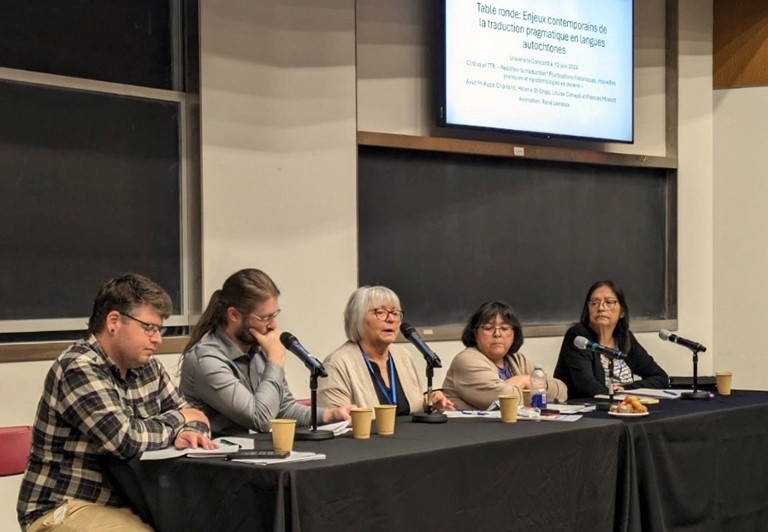Concordia hosts the 1st roundtable on pragmatic translation of Indigenous languages in Quebec
 René Lemieux: “It's crucial to give voice to the practitioners of translation.”
René Lemieux: “It's crucial to give voice to the practitioners of translation.”
Concordia recently hosted a roundtable discussion on the pragmatic translation of Indigenous languages. The event marked the first of its kind, where individuals from various nations gathered to discuss translation issues.
“Such events are common for language teaching, but not for translation practice, which remains somewhat taboo. Most translators are not professionals and have never received formal training in the field,” notes René Lemieux, assistant professor in the Département d’études françaises. Lemieux and others from the Indigenous Translation Observatory organized the discussion.
“It’s also in the nature of translators to remain in the background.”
The roundtable was part of the TTR (Traduction, Terminologie, Rédaction) journal's 35th anniversary conference, "Redefining Translation? Historical fluctuations, new practices, and epistemologies in the making," in collaboration with the Canadian Association for Translation Studies.
The focus of the event was put on pragmatic (as opposed to literary) translation for its ability to address the translation of concepts unfamiliar to the specific communities where the texts are translated, requiring translators to innovate lexically, sometimes creating new terms. A unique challenge in pragmatic translation is the anonymity of translators, making it difficult to trace the origins of translations and connect with the translators themselves. This poses a methodological challenge for research.
Community and linguistic diversity
Among the panelists were Hélène St-Onge, a technolinguist, and Louise Canapé. The two work on the Lexique spécialisé des études collégiales en français-innu created for the Cégep de Baie-Comeau. St-Onge and Canapé also work at the Pessamit Innu Council and are translators of Innu-aimun.
St-Onge emphasizes the importance of considering the audience in translation, including dialect preferences and the purpose of the translation: “A publication intended for all Innu people uses standardized spelling. A translation for a specific community, like Pessamit, uses terms unique to that community, with spelling closer to their pronunciation, known as lelueun,” she explains.
Canapé brings our attention to the process of creating new words: “We start by asking community radio listeners to suggest possible Innu-aimun translations for a French word,” she shares.
“We then present five options on Facebook, gather feedback and hold a vote. The final choice is confirmed with community Elders. It's crucial to involve Elders in the translation process; they may propose alternatives if the suggested translations are not well understood.”
Reviving ancient words
Philippe Charland, an Abenaki language professor at Kiuna College and other institutions, uses old manuscripts of Abenaki dictionaries and lexicons, including the oldest known one by Jesuit missionary Sébastien Rasles from 1691, for his translations. The Awikhiganisaskak project at Université de Sherbrooke, of which he is a part, aims to transcribe these manuscripts, facilitating research.
“Each missionary introduced different spellings,” he says. “Recognizing them is essential. Transcribing these old manuscripts is crucial for reviving old words.”
Advocating for Indigenous language education
Frances Mowatt, of the Abitibi8inni Nation, is an Anicinapemo8in translator who was recently awarded an honorary doctorate from the Université du Québec en Abitibi-Témiscamingue. She advocates for teaching Indigenous languages to young people. Mowatt recalls her mother’s insistence on her children learning the language from a young age, while also learning how to speak French. Her mother also contributed to passing the language to her grandson. “Knowing Anicinapemo8in helped me learn French,” she says. “It never hindered me.”
A collaborative exercise
As a concluding exercise, the roundtable participants were asked to translate the term “Canadian Association for Translation Studies.”
Charland proposed “Kanadi8ïm8wkaw8gan wji agakimzimek azwawakal8dwaw8ganal” (literally: “the Canadian gathering for those who study the work of language exchange”). Mowatt suggested “Kanada inotamake8innik ka ok8api8atc” (literally: “the translators of Canada sit in a group”).
Canapé and St-Onge offered “Mamu ka atusseshtakau e ashushtakannit ute Kanata assit” (literally: “together, those who work to translate, here on the land of Canada”).
Lemieux highlights the broader significance of such initiatives: “It's crucial to give voice to the practitioners of translation. Many translators have learned the profession on the job without institutional support. In this sense, the role of the university is evolving: it's not just about offering opinions on realities outside the university but creating spaces for these kinds of events to happen.”
The recording of this first roundtable can serve as a pedagogical resource, laying the foundation for specialized training in Indigenous language translation.
Find out more about the Indigenous Translation Observatory and the impactful work of the Office of Indigenous Directions at Concordia.


